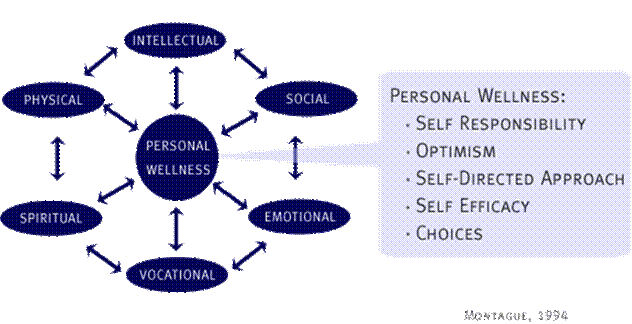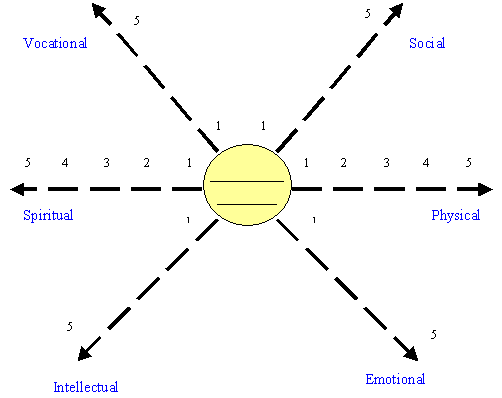About Whole-Person Wellness
Programming at the Center for Successful Aging is developed around the principles of whole-person wellness to help our clients maintain a lifestyle that is of the highest quality. Whole-person wellness embodies a comprehensive approach to wellness, which respects our complexity by acknowledging that we are multidimensional beings. It is through attention to and the development of each dimension of wellness that we can be successful in achieving whole-person wellness.
Our programming is based on a whole-person wellness model that integrates six essential dimensions of wellness. This model was developed by Jan Montague, MGS, who developed the principles of whole-person wellness for use in older-adult settings.

Whole-person wellness represents the integration of an individual's multiple dimensions into positive beliefs and meaningful activities. It is relative to the individual, has nothing to do with age, and the process and attainment are behavior specific. Whole-person wellness promotes the concepts of moderation, rather than excesses; finding balance among various facets of life activity; the importance of a personal role in shaping one's health; providing a broad framework for the integration of activities to enhance human functioning and quality of life; and the pursuit of individual efforts and to be as healthy as possible in the areas of emotional, intellectual, physical, social, spiritual and vocational health.
Six Dimensions of Wellness
Following is a more complete definition of each of the six dimensions of wellness.
Emotional Wellness:
Promotes an awareness and acceptance of one’s feelings. It reflects the degree to which an individual feels positive and enthusiastic about one’s self and life. This dimension involves the capacity to manage feelings and behaviors, self acceptance, and coping with stress and life’s challenges.
- Ability to give and receive love.
- Ability to understand and express feelings/emotions.
Intellectual Wellness:
Promotes the use of one’s mind to create a greater understanding and appreciation of one’s self and others. It involves one’s ability to think creatively and rationally. This dimension encourages an individual to expand his/her knowledge and skills-base through a variety of resources and activities.
- Developing and expressing creativity.
- Processing information effectively.
Physical Wellness:
Promotes participation in personal safety and activities for cardiovascular endurance, muscular strength, balance and flexibility. This multi-faceted dimension is relative to each person’s abilities and disabilities. It promotes healthy lifestyle habits and discourages negative and excessive behavior.
- Physical activity and fitness.
- Immune system function.
- Body composition.
Social Wellness:
Promotes creating and maintaining healthy relationships. It enhances interdependence with others and nature, and encourages the pursuit of harmony and feelings of connectedness.
- Quality and quantity of relationships.
- Fostering a social network through personal relationships.
Spiritual Wellness:
Promotes seeking meaning and purpose in human existence. It involves developing a strong sense of personal values and ethics. This dimension emphasizes the development of an appreciation for the depth and expanse of life and natural forces that exist in the universe.
- Feeling connected to someone or something beyond oneself.
Vocational/Occupational Wellness:
Promotes the process of determining and achieving positive personal and occupational goals and interests. This dimension is linked to discovering an individual’s “calling” in life, and encourages one to be a good giver and receiver of life’s gifts.
- Feeling good about one’s contributions to the world.
Defining Your Whole-Person Wellness Journey
Now that you understand whole-person wellness and the six dimensions of wellness, we encourage you to complete several activities to help you achieve whole-person wellness.
Activity 1: Wellness Wheel
This activity assesses the wellness dimensions in which you have strengths and the dimensions that will benefit from your attention. Once you have completed the activity, evaluate what factors have led to your areas of strength. Is that where you are spending more time? Do you enjoy that area the most? Does your health cause you to focus on that area more? Now consider how you can capitalize on those strengths to improve in the wellness dimension(s) that you feel you are not performing as well in.
Follow the steps below to complete the Wellness Wheel Activity. Consider re-assessing your Wellness Wheel at least one each year to see if you have made changes affecting any of your wellness dimensions.
Click here to download the form to complete your Wellness Wheel.![]()
Step 1
Choose a personal wellness concept to focus on and write it in the center of the Wellness Wheel.
Personal Wellness Concepts Examples: Choices, Optimism, Being in the Moment, Self-Efficacy, Happy, Self-Responsibility, Learn
Step 2
Rate your level of wellness in each dimension by placing a mark on the line corresponding to each dimension of wellness:
1 – Not So Well
2 – Kind of Well
3 – Well
4 – Very Well
5 – Unbelievably Well
Step 3
Connect your marks and see if your Wellness Wheel will roll.

Activity 2: Goal Setting
Setting and working towards accomplishing goals is an important part of achieving success with your whole-person wellness. Each semester we encourage you to define new or update existing goals for each of the six dimensions of wellness – emotional, intellectual, physical, social, spiritual and vocational.
Goal setting can be a challenging process, but the rewards of accomplishing your goals can be tremendous. The best-known method to achieve success with your goals is to define S.M.A.R.T. goals. S.M.A.R.T. is a tool to help you remember and perform effective goal setting.
What are S.M.A.R.T. goals?
S = specific – can you define who, what, when, where and why of the goal?
M = measurable – can you define how much, how many, how frequent so you can measure your progress toward achieving the goal?
A = attainable – is the goal one you have the means, attitude, and skills to accomplish
R = realistic – is the goal reasonable for you to tackle at this time; do you believe you can accomplish it in the time-frame you’ve defined?
T = time-bounded – what is the time-frame when you expect to accomplish the goal? This links back to the goal being measurable, attainable and realistic.
Let’s look at several examples of turning a goal into a S.M.A.R.T. goal.
Example 1: I want to exercise more.
Making that goal S.M.A.R.T. could be: For the next 90 days, I will walk at a brisk pace (get my heart-rate elevated) for 20 minutes following dinner Monday-Friday. (After 90 days, increase the goal to include 30 minutes of walking.)
Example 2: I will lose weight.
Making that goal S.M.A.R.T. could be: Every day I will eat 1-2 vegetable servings (~1/2 cup) at lunch and a serving/piece of fresh fruit with breakfast and lunch.
Example 3: I will reduce my stress.
Making that goal S.M.A.R.T. could be: On Monday, Wednesday and Friday, I will take 5 minutes in the morning to practice meditation (or deep-breathing, yoga, read calming passages, etc.).
Incorporate the phrase “I will” into your goals to make the statements more affirmative and to help you be accountable.
Goals do not have to be large and burdensome. But goals should cause you to stretch a bit, and do something different than what you have already been doing. The sense of accomplishment and the reward of a rich and fulfilling life is worth the effort!
Now that you know how to develop S.M.A.R.T. goals, it’s time to document your goals for the next 6 months.
Download and print the whole-person wellness goal setting contract by clicking here.![]() For ideas of goals and examples of how to write S.M.A.R.T. goals, review the goals setting examples document by
clicking here
For ideas of goals and examples of how to write S.M.A.R.T. goals, review the goals setting examples document by
clicking here![]() .
.
We hope you will enjoy the journey of defining and accomplishing your goals. We wish you success and encourage you to ask us for assistance if you are struggling with defining or accomplishing your goals.
If a man knows not what harbor he seeks,
any wind is the right wind.
-Seneca (Roman philosopher)
